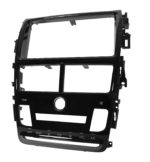What It Takes to Get Your IML Product Created [Timeline]
February 21, 2022 • Posted in In Mold Labeling
A customer will make a snap judgment about a product in just seven seconds.
Obviously, the journey of conception, drawing, testing, production, and (finally) putting a product in front of a customer’s eyes takes much longer. But how much longer? When it comes to in-mold labeling (IML), we can tell you how long each phase of production takes (on average), and what to expect at each step.
If you’re wondering how to get started with your IML product, or what to expect for a production timeline, you’re in the right place!

Step 1: Submitting your design (1-10 days)
Some clients come to us with everything we need to get started — they’ve had IML parts printed before and know the drill. For others, it’s the first time and it takes some back-and-forth to get the initial drawings and designs finalized.
Here’s what your IML manufacturer will want:
A drawing or rendering. 3-D CAD is best for accurate feedback from the manufacturer, although a 2-D drawing (such as a PDF) that shows dimensions will work as well.
Color specifics, such as name, color number, and finish. A Pantone color book can assist will nailing down the closest color target
A list of materials: ABS, PET, PC, PMMA, PVC. At Sanwa, we always offer feedback based on our initial conversations, but a starting point with material specs is helpful.
A general timeline that includes a goal for the start of mass production.
Your estimated annual units (EAU) so your manufacturer can factor in initial quantities and repeatability.
Your non-disclosure agreements (NDA) if needed.
Where the parts are going to be delivered after production. Some countries have strict import restrictions, which can affect the quote and timelines.

Step 2: Receiving and approving your quote (3-5 days)
This process may be shorter or longer depending on your IML manufacturer. At Sanwa, we choose to spend a little extra time confirming and reconfirming all the details. We’d prefer to give a complete and accurate quote early, and not surprise our customers later with additional costs due to not verifying material costs or design features.
Step 3: Design confirmation and DFM review (2-3 weeks)
In this phase, the IML manufacturer will go back and forth with their customer to finalize design specs and complete a Design for Manufacturability (DFM) review. In short, a DFM is the practice of designing parts and products that can be easily manufactured without errors, weaknesses or flaws. Customer communication can play a big role in making this step take longer or shorter. If you can get back to your IML partner with feedback ASAP, you can shorten the review timeline significantly (or on the opposite end, stretch it out longer if your drawings have errors or you’re taking longer to reply).

Step 4: Injection mold and tooling creation (8-12 weeks)
This timeframe can vary depending on the complexity and size of your product. In order to create in-mold labeling parts, your manufacturer must first create the mold. Oftentimes, parts also require specific tooling for production, such as jigs or fixtures. This is the “prep work” phase of the process, so that a factory can effectively scale production and improve efficiencies down the line (like low scrap and breakage rates).
Step 5: Tuning, trials and testing (4-7 months)
The length of this phase all depends on a company’s requirements. Some larger companies have complex testing metrics that have to be met, while others may have far fewer. For instance, a high-end auto interior part may require extensive UV testing, chemical testing, scratch/abrasion testing and water testing. If a 1,000 hour UV test is required, that alone will take 41 days to complete.
Knowing your testing requirements ahead of time can save you days, weeks and even months down the road. At Sanwa, we offer basic testing in-house (and work with other impartial lab partners, but some companies require their own on-site testing, too. This means drafted products have to be manufactured, shipped, and then sometimes altered and re-sent based on results.
Step 6: Mass production start and ramp up (4-6 weeks)
Finally, your part is ready to be mass produced! Depending on the quantities you’re producing, this phase can take shorter or longer. At Sanwa, we start shipping parts as soon as they're ready, which means customers may receive shipments in batches (100 pieces the first week, 200 pieces the next week, 300 pieces the following week, and so on). Your preferred shipping method will have an impact on the timeline, too. Delivery by air can take 7-14 days, while overseas delivery can take 6-8 weeks (or more depending on global shipping delays).
You have the power to shape your IML production timeline
Remember that you can shorten or lengthen a lot of these steps with communication and preparation. We collaborate with our customers throughout the design and IML process, which can mean a lot of discussions along the way. So if you can provide feedback and requirements quickly, it’ll make a big difference in your overall production timeline.
Have more questions? Our Sanwa team has more than 40 years of experience bringing IML parts to life for some of the largest name brands in the auto, appliance, medical, and aerospace industries. Over the years, we’ve honed our own best practices for creating high-quality IML products from beginning to end. We’re happy to share our input about what to expect at any stage of production, and to point you toward the starting line of your next big project.